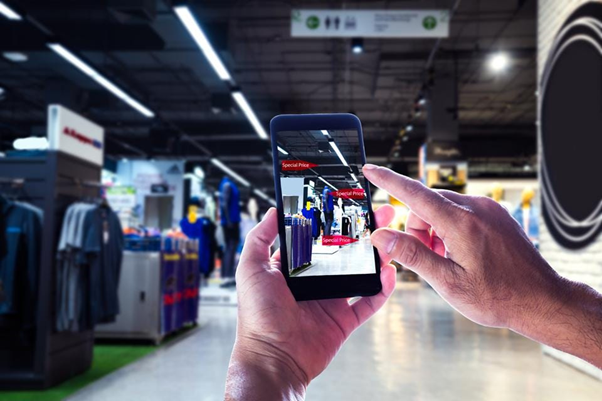Augmented reality (AR) is a field that a few decades back seemed futuristic but is now finding applications across industries. At the onset, it is necessary to distinguish the concept of augmented reality from that of virtual reality (VR) which do appear similar at a glance but upon closer inspection, have a lot of differences. Virtual reality completely immerses users in a simulated reality with the help of devices and equipment such as headsets, sensors, and gloves which transport the user to an alternate reality. Augmented reality on the other hand superimposes information and images in a real-world environment. Users can interact with real-world objects but in a digitally manipulated environment.
AR experiences can be achieved through devices such as smart glasses, smartphones, tablets. Unlike VR which requires specialized equipment to provide a fully immersive experience, AR works with devices with cameras and displays that can provide the user with overlaid information on the real environment and can be easily applied to processes like manufacturing. These devices also support AI and IoT, technologies which are bringing major changes in the manufacturing sector.
How AR Can Enhance Manufacturing
Product Development
Innovating and rapidly developing prototypes in response to competition, technological advancement, environmental regulations, and rising customer expectations are putting pressure on manufacturing companies. The need for product development delivery in a shorter time to market and at reduced cost requires companies to look at emerging technologies such as AR. AR can accelerate collaboration from conceptualization to development, to introduction into an assembly line to quality checks. Performing these tasks virtually using AR can increase speed, reduce costs, and help create better products.
Safety
Workers in the manufacturing industry are at risk of injuries and mishaps because of the work environment which tends to be heavily mechanized, have extreme temperatures, and include the probability of exposure to hazardous chemicals and toxic substances. Organizations take employee safety seriously, but when working in a real-world environment, there remains a risk of accidents. With AR, information about the work environment overlaid and available through AR-enabled devices can not only increase manufacturing safety but also increase efficiency. Expert advice and real-time safety alerts through AR headsets can further ensure manufacturing safety.
Training
AR can be used for training new hires and shortening the learning curve by providing an enhanced experience of their work environment in a safe and interactive manner. Information of physical assets can be used with AR technology to provide an immersive experience of using, maintaining, and repairing equipment without putting them in a hazardous environment. While using wearable devices, employees can receive expert advice on tasks at hand which can lead to increased learning and efficiency.

AR for Employee Training | Image Source: Forbes
Maintenance
Machine breakdowns and downtime is a major concern for industries as it leads to production loss and affects continuity. The sophistication and complexity in manufacturing lead to increased requirements for maintenance efforts. AR can monitor machinery and processes in real-time and detect flaws while providing diagnostics for repairs and future prevention. With faster issue resolution and less downtime, AR can help manufacturers reduce costs and increase efficiency.
Customer Support
Providing customer support for services that require technician visits for running diagnostics, ordering spare parts, and repairing equipment can be a slow and arduous process that negatively impacts the customer experience. AR can help improve this process by helping customer support with smart glasses and access to personalized information in real-time so that they can accurately and swiftly resolve issues working from a remote location.












